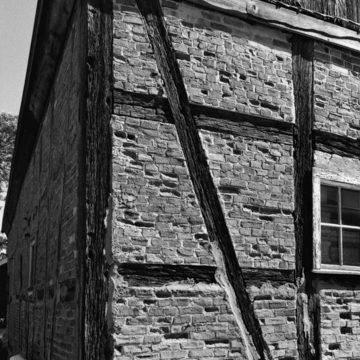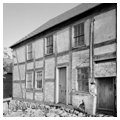You are here
Kliese Housebarn
Although rare in America, housebarns—structures sheltering people and livestock under the same roof—were common in Europe, at least since medieval times. In the oldest housebarns, people and animals commingled, but by the nineteenth century an interior wall usually divided the building into separate spaces with separate entrances. Wisconsin had at least seven housebarns, mostly in Dodge and Manitowoc counties, where many German immigrants settled.
This housebarn is the state’s best known. Two stories tall, it shows off the German building technique of fachwerk. Over time, the owners replaced the original nogging with cream brick on the barn’s eastern end (which housed people) and covered it with vertical boards on the western end (cattle and hay). Between the two living spaces was a large brick, barrel-vaulted schwarze Küche (“black kitchen”), where the women cured meat and baked bread. Friedrich and Frederika Kliese, immigrants from Prussia, built the housebarn probably between 1846 and 1851 and lived there with their six children and seven cattle. They soon sold it to another family of German immigrants. The Langholff name, by which the building is commonly known, comes from a more recent owner.
Writing Credits
If SAH Archipedia has been useful to you, please consider supporting it.
SAH Archipedia tells the story of the United States through its buildings, landscapes, and cities. This freely available resource empowers the public with authoritative knowledge that deepens their understanding and appreciation of the built environment. But the Society of Architectural Historians, which created SAH Archipedia with University of Virginia Press, needs your support to maintain the high-caliber research, writing, photography, cartography, editing, design, and programming that make SAH Archipedia a trusted online resource available to all who value the history of place, heritage tourism, and learning.













